AMD Frame Pacing Explored: Catalyst 13.8 Brings Consistency to Crossfire
by Ryan Smith on August 1, 2013 2:00 PM ESTCatalyst 13.8 Results in Summary
For this article we’ve decided to do things a bit differently and lead in with a summary of our results, rather than starting with detailed results and then going to a summary. Based on past feedback most of you want to quickly know whether this works at all and how well it works, which is something we can quickly cover first before diving into individual games.
We’ll start with the graph that is of the most importance: delta percentages on a 7990, comparing Catalyst 13.6b2 to Catalyst 13.8b1 with frame pacing enabled.
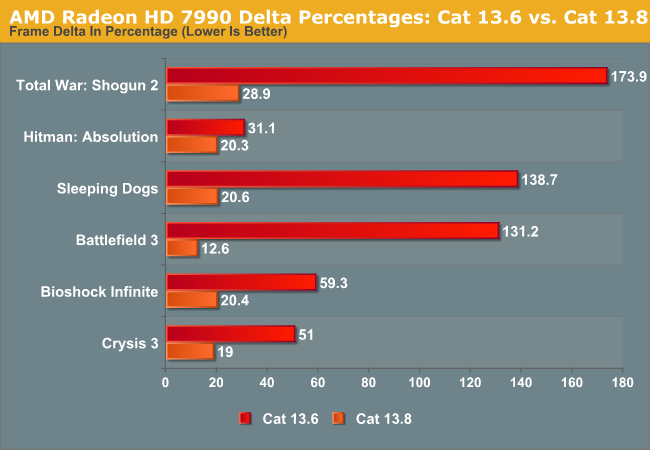
The results, quite frankly, speak for themselves. In roughly half of our 6 games AMD had absolutely absurd frame pacing on Catalyst 13.6. Total War, Sleeping Dogs, and Battlefield 3 all had massive pacing issues that were the result of second frames coming far too soon after first frames, leading to a high instance of “runt” frames – that is frames that are only shown for an incredibly short period of time before being replaced with a newer frame. These are the games where micro-stuttering and/or the feeling of lower frame rates would be the most apparent.
Earlier we decided that our cutoff would be 15%-20% for an “acceptable” range for delta percentages on a multi-GPU setup, and with the exception of Total War: Shogun 2 (the only non-action game in this collection), AMD has just managed to hit that. How smooth this is going to be perceived is going to vary on a person-by-person basis, but this is right where we’d say micro-stuttering and other issues become generally unnoticeable.
For the more visually inclined, we’ve also quickly cooked up frame time graphs in FCAT showing the two 7990s. The full series is below, but we’ll print in full the Total War: Shogun 2 graph in full since it was one of the bigger problem cases for AMD’s cards without frame pacing. Shogun doesn’t have any scene transitions, but it does have some snap camera movements that leads to a clear separation between scenes. In each scene we can clearly see the much lower variability with Catalyst 13.8 with frame pacing turned on, as opposed to 13.6 with frame pacing turned off.
Similarly, turning off frame pacing results results in Catalyst 13.6-like behavior, with much higher variability compared to having frame pacing turned on.
Moving on, the next question on most readers’ minds will probably be performance. What’s the performance sacrifice for using this new frame pacing mechanism? AMD said that the performance hit should be non-existent, and strictly speaking within Catalyst 13.8 that’s true, as we get identical frame rates with it on or off. However compared to Catalyst 13.6 we are seeing a performance regression.
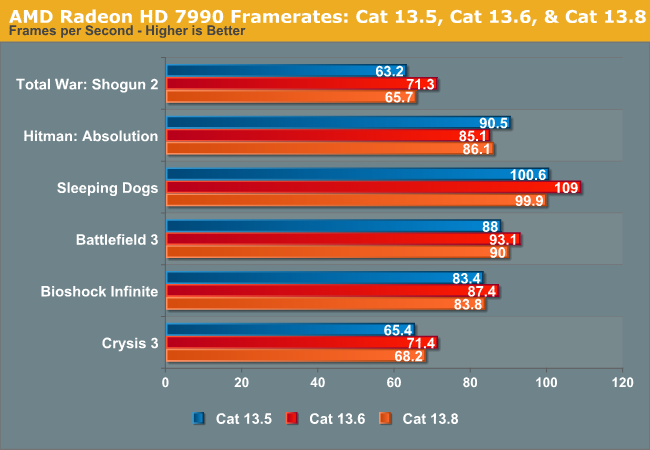
With the exception of Hitman: Absolution, performance is down across the board on 13.8 versus 13.6. The specific performance losses vary on the game, but we’re looking at 5-10%. However compared to the 13.5 launch drivers and again with the exception of Hitman AMD’s performance has held constant or increased. So at the very least when it comes to frame rates AMD is no worse off than they were at the launch of the 7990.
Our next summary graph is plotting the 7970GE against a pair of 7970GEs in Crossfire, to take a fresh look at AFR (Crossfire) versus a single GPU. Our editorial position has been and remains that we favor a single larger GPU over a pair of smaller GPUs when this approach is practical, and this chart demonstrates exactly why.
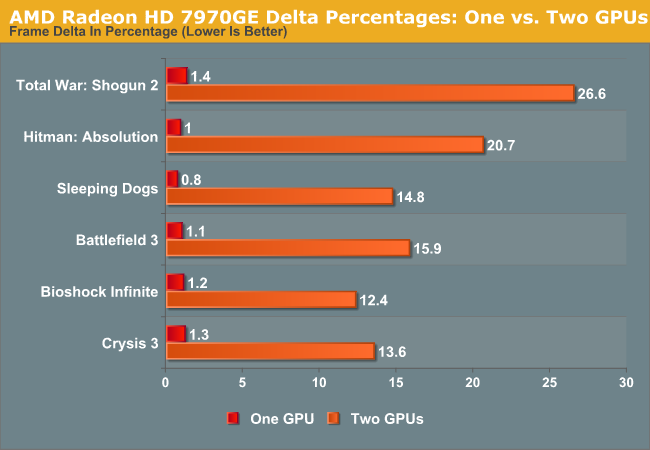
The delta percentages on the single 7970GE are all under 2%, versus 12%+ for the Crossfire setup. AFR simply cannot match the consistency of a single GPU at this time, which is why a high AFR is best left to being pursued after single-GPU performance has been exhausted.









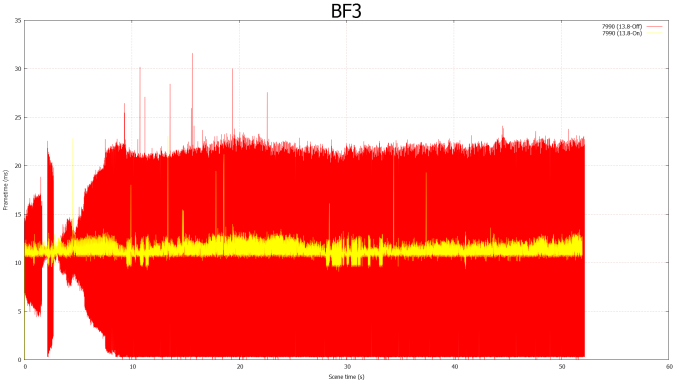
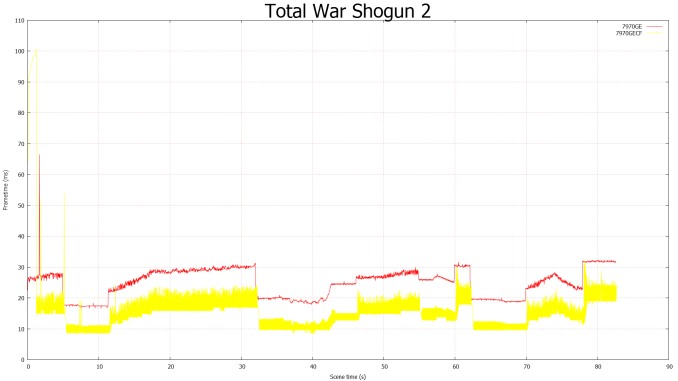














102 Comments
View All Comments
chizow - Saturday, August 3, 2013 - link
Written on the walls at AMD Driver HQ I'm sure, quickly referenced when questioned about microstutter being worst on CF.krutou - Friday, August 2, 2013 - link
BUT, BUT, BUT, RADEON PRO?!?LordOfTheBoired - Saturday, August 3, 2013 - link
Took them by the hand? Looks more to me like "waited until people cared, then released a benchmark to prove they didn't have the problem, while offering no constructive commentary."And the hell of it is... AMD's stance makes sense. This IS a market that hates VSync because ZOMG LAG. "The market" has made it ABUNDANTLY clear that they have no interest whatsoever in technologies that improve the visual experience at the (real or imagined) cost of responsiveness.
But apparently that's only true when there's the visual equivalent of a record skip on your screen and not when it's a subtle frame rate fluctuation. The former is a good thing because it means you "aren't lagged", the latter is a horrible thing because it means you "aren't lagged".
chizow - Wednesday, August 7, 2013 - link
@LordOfTheBoired - this is the type of indignant attitude that got AMD and their fans in this predicament to begin with.mikato - Wednesday, August 7, 2013 - link
Well one result of Nvidia releasing the software was to allow tech journalists to shine a bright spotlight on a problem of their competitor's products. Your "holding AMD by the hand" idea is pretty amusing.novastar78 - Wednesday, August 7, 2013 - link
What's sad is that AMD has ripped ATi to shreds to the point where they are spread pretty thin. Just getting a working product out the door is a task. You are being waaay too hard on them.They were using traditional methods to test and frankly it's not so unimaginable that they were caught by this. Granted, maybe it should have been caught sooner, but to demonize them or put them down for it seems a bit harsh.
They know now that it's a big problem are definitely committed to fixing it. You can clearly see that they are trying to stabilize the company and there is lots of turmoil. The moves they are making and the people being brought on board are a good sign. There is definitely a process change that needs to happen but when the tree is being shaken so many times too many apples can fall.
Give it some time, I think we will see great things form them over the next few years.
Wreckage - Thursday, August 1, 2013 - link
It did not help that certain people were claiming that AMD does not have a stutter problem.DanNeely - Thursday, August 1, 2013 - link
The problem is that AMD didn't think they had a stutter problem; or more precisely, until 3rd parties shoved the reality in their face they assumed (without testing) that they and nVidia had equal amounts of the problem.I suspect at one point in the past they were right; and that the genesis of nVidia's "years in the making" tool to measure the problem dates back to when they discovered it was a problem internally and began working on fixes so that they could announce the same tool at the same time that their drivers had a negligible impact from it. It'd be interesting to see what would happen if someone tested SLI card/driver configurations from a few years ago to see how well nVidia did at the time.
BrightCandle - Friday, August 2, 2013 - link
NVidia has had this fixed for a lot longer than that. The 680's were noticeably smoother on their release day compared to the 7970 crossfire. NVidia has claimed they have been fixing this since the 8800 and there is no reason not to believe them as HardOCP and other review sites have been noting the difference for years.HisDivineOrder - Friday, August 2, 2013 - link
Exactly. This has been a problem for as long as there has been Crossfire. I think a lot of people are so shocked by this fact (because some of them owned Crossfire and just dealt with it and didn't realize they were getting shafted) they can't accept it.Yes, you got reamed. Yes, for years, you were using Crossfire and suffering from microstutter when you needn't have to. Yes, AMD took you for a ride. It's so infuriating it drives people not to want to believe it because to believe it would be so horrible as to suddenly be intolerable.
Do what most people do. Just stick with nVidia since you know they do proper testing. Boycott AMD for a five year period and come back once you're sure AMD's got their act together.